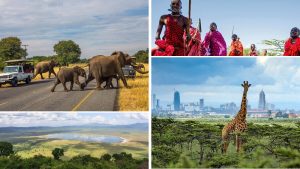The Evolution of Serengeti National Park Boundaries
Serengeti National Park, located in Tanzania, is a renowned wildlife sanctuary and home to a diverse array of animals, including the iconic Big Five. The park is famous for its annual wildebeest migration, where millions of animals travel across the plains in search of greener pastures. The park’s boundaries have evolved over the years, reflecting changes in conservation priorities, land use, and political developments.
Historical Development of Serengeti National Park
The history of Serengeti National Park dates back to the early 20th century when the British colonial government declared the area a game reserve in 1921. At that time, the reserve covered an area of approximately 3,200 square kilometers. In 1951, the reserve was expanded and upgraded to a national park, making it one of the oldest national parks in Tanzania.
Over the years, the park’s boundaries continued to change as new areas were added to protect critical wildlife habitats and migration corridors. Today, Serengeti National Park covers an expansive area of over 14,750 square kilometers, making it one of the largest protected areas in Africa. The park is also part of the larger Serengeti ecosystem, which includes neighboring reserves and conservation areas.
Changes in Serengeti National Park Boundaries
The evolution of Serengeti National Park boundaries has been influenced by various factors, including conservation priorities, land use conflicts, and political decisions. One significant change occurred in the 1960s when the Maswa Game Reserve was integrated into the park to provide additional protection for wildlife populations. This expansion also helped to secure critical migration routes for the park’s iconic wildebeest herds.
In recent years, there have been ongoing debates and controversies surrounding the park’s boundaries, particularly in relation to human-wildlife conflicts and land use practices. The establishment of buffer zones and wildlife corridors around the park has been a key strategy to mitigate these conflicts and maintain connectivity for wildlife populations. Efforts are also being made to address issues such as poaching, habitat destruction, and illegal grazing, which threaten the park’s biodiversity.
As the boundaries of Serengeti National Park continue to evolve, it is essential to balance the needs of conservation with the interests of local communities and stakeholders. Sustainable management practices and community involvement are crucial for the long-term protection of the park’s wildlife and habitats. By working together, we can ensure that Serengeti National Park remains a thriving ecosystem and a symbol of Tanzania’s rich natural heritage.
For an unforgettable safari experience in Serengeti National Park, book a tour with Sunset Africa Safari. To inquire about booking options, please contact info@sunsetafricasafari.com. Discover the beauty and diversity of Serengeti’s landscapes and wildlife with our expert guides and customized itineraries. Don’t miss the opportunity to witness the magic of the Serengeti firsthand and create lasting memories in this iconic African wilderness.


